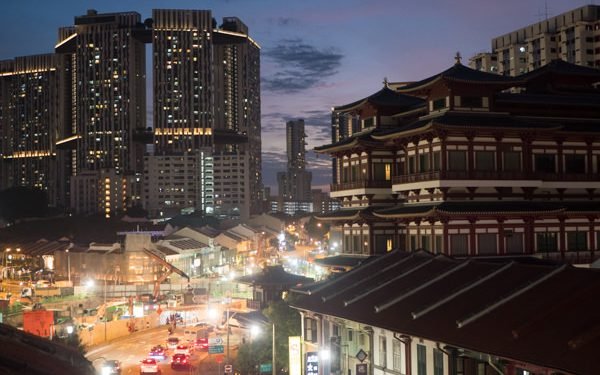The thriving city-state of Singapore feels like a world apart from many other places in Southeast Asia.
It’s highly developed, spotlessly clean, and meticulously planned and architected — a far cry from the congestion, noise, and erratic development seen in many other Asian capitals.
I’m a big sucker for the chaos and spontaneity of places like Hanoi or Bangkok, but I must admit that Singapore’s high-tech style is very interesting in a different way.
Even though most people know it as a financial center, there is more to Singapore than meets the eye. It makes for a convenient pit-stop when traveling in Southeast Asia, but it’s also highly worth visiting in its own right!
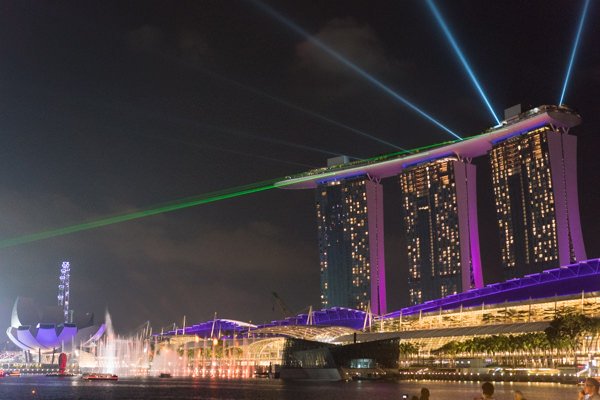
I’ve been to Singapore a few times, usually on a 1- or 2-day layover. One time, I also stayed for a week while visiting a friend, which gave me a bit more time to poke around. I do think you can get a pretty good feel for Singapore in a couple of days as the distances on the island are quite manageable — and the best sights are easily seen in a short amount of time. Still, there’s always more to discover if you stick around longer!
Singapore is a super easy travel destination: it’s well-organized, English-speaking, and almost totally hassle-free. Keep in mind it’s not particularly cheap though, especially if you’re used to the low prices in other nearby countries. Thankfully, there are many ways to keep your costs under control.
Where to stay in Singapore
If you’re on a tight budget then hostels are always a good way to save money in Singapore. Below are a few backpacker hostels that I recommend.
Most travelers base themselves in or near Chinatown, Kampong Glam (the Arab quarter), or Little India.
Great hostels in Singapore
Fine Stones
Modern hostel located in Kampong Glam. Dorms and several private rooms available.
Beary Best!
Located in the middle of Chinatown. Dorms and one private room.
The Hive
Cheap for Singapore, located a few blocks from Little India. Stayed here a few years ago and recommend it!
5footway.inn Project Ann Siang
Stayed here on my most recent visit. Clean & comfy, with roof terrace looking out on the Buddha Tooth Relic Temple in Chinatown.
Things to do in Singapore
There is plenty to see and do in Singapore, and luckily some of the best activities are free. Here are some of my top picks:
Stroll through the Gardens by the Bay

Since opening in 2012, the Gardens by the Bay quickly became the city’s most iconic site. Your visit won’t be complete without seeing the massive Cloud Forest Dome (containing the world’s largest indoor waterfall) or the Supertree Grove (home to futuristic tree-like vertical gardens, with a light show at night).
Cost: outdoor gardens are free, walking the skyway is $8 SGD, and the cloud forest is $28 SGD
Visit the Marina Bay Sands & Mall
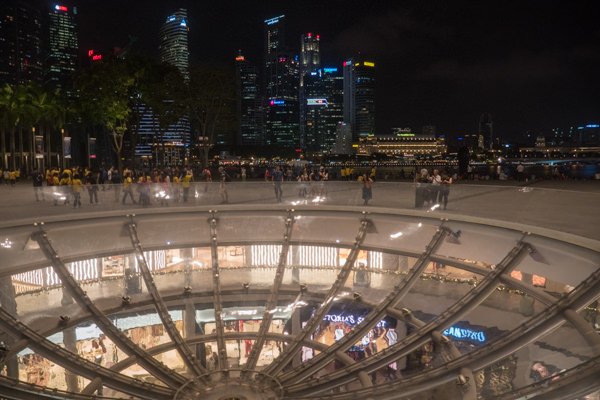
At the Marina Bay you can experience Singapore in its full futuristic glory. Squint your eyes a bit and parts can seem like a future Earth from Star Trek. There’s a multi-level mall with an indoor canal, a bayfront boulevard, and great views of the financial district’s skyline. Louis Vuitton also set up an enormous shop here on a kind of mini-island, accessed via an underwater tunnel. It’s a pretty extravagant place.
At the top of the Marina Bay Sands building is a hotel with an infinity pool. It became a ridiculously sought-after Instagram spot, though these days it’s open only to hotel guests. There’s also an observation deck giving panoramic vistas of Singapore’s cityscape and as the shipping lanes through the Singapore Strait.
Cost: free to walk around, $23 SGD for the observation deck
Budget travel hack: you can sneak into the Marina Bay Sands observation deck for free by telling the staff “you’re just going to the bar”. Walk in and they’ll assume you’re a hotel guest.
Eat at a Hawker Center

Looking for a cheap eat? Then look no further than Singapore’s many hawker centers, which are open-air complexes with stalls selling lots of affordably priced food.
First introduced in the 1970s to deal with rampant street hawking at the time, the centers are now a unique aspect of Singaporean culture. They’re basically a regulated form of street food with proper hygiene standards put in place. Many migrants from around Asia ended up working in the hawker centers, so you can sample a huge variety of cuisines. Whether it’s Indonesian, Chinese, Malay, Indian or Thai, you can get it here.
You can find a good list of Hawker centers here. A slightly more hipstery version of the concept also exists at Gluttons Bay, which offers wonderful bay views and some of the best cooks (drawn from other centers) making their signature dishes.
Cost: a few Singapore Dollars for a tasty meal
Explore colorful Chinatown

In the old Chinatowna, the futuristic high-rises and business districts give way to British colonial architecture with pastel colors. Several Hindu temples, mosques, and other places of worship are also scattered across the town. There is an excitement and hustle in this district that makes it one of the most popular areas for visitors to go. It’s great for a wander, and a good area to find a nice hotel or hostel too.
You can get to Chinatown with the MRT metro and explore by foot from there. Follow this self-guided temple walking tour and be sure to pass by the Hindu Sri Mariamman Temple and Buddha Tooth Relic Temple — some fine examples of the cultural and religious melting pot that is Singapore.
Cost: free
Wander through Haji Lane & Little India
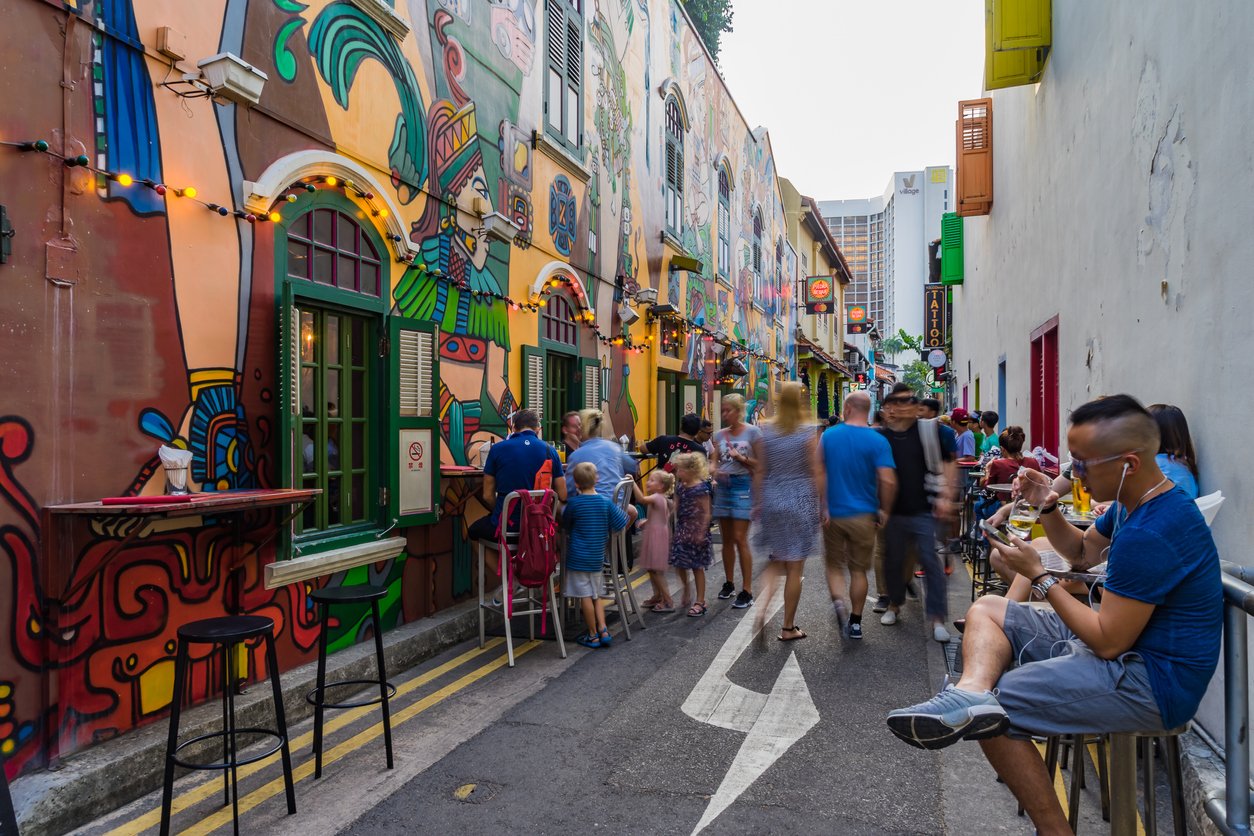

Singapore can sometimes be orderly to a fault, but its narrowest street reminds you that pockets of creativity do manage to thrive.
With its boutique shops, Middle Eastern cafes, and street art-covered facades, Haji Lane is known as Singapore’s original hipster enclave. Until the 1960s, the shophouses were used as lodges for Hajj pilgrims on their way to Mecca. Nowadays, they’re home to many trendy fashion shops.
The adjacent Arab Street and surrounding neighborhood form Kampong Glam, Singapore’s vibrant Muslim quarter. You can learn more about its history at the Malay Heritage Centre, which is free to enter.
Just a stone’s throw across the Rochor River is Little India, another one of Singapore’s vibrant ethnic neighborhoods. While you’re there, don’t miss seeing the colorful Sri Veeramakaliamman Hindu temple.
Cost: free
Escape to Singapore’s green spaces

Singapore is sometimes dubbed the “Garden City”. It does have quite a few green spaces! Apart from the Gardens by the Bay, I liked climbing the hill in Mount Faber Park, where you can get a nice view of the city and walk across the unique Henderson Waves pedestrian bridge.
And in Bukit Timah Nature Reserve, which is only about 12km from downtown, you can enjoy a wonderful slice of primary rainforest filled with walking trails.
Cost: free
Grab a drink at Clarke Quay
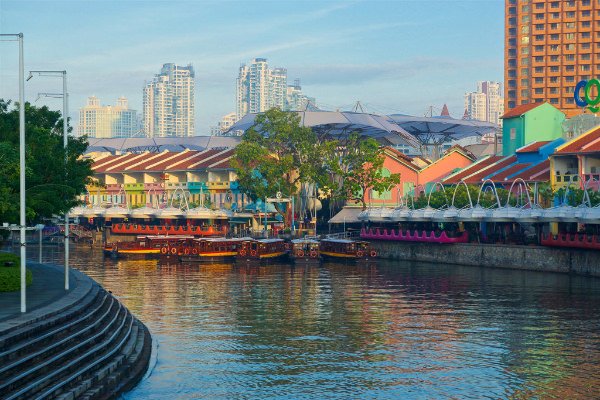
Clarke Quay is a historical riverside area where ships once docked during the British colonial times. Nowadays, the restored warehouses are occupied by many restaurants and nightclubs.
Expect to find more a commercial than a historical area (I mean… there’s a Hooters here). That said, it’s definitely nice to have a cold beer on the terrace on a sunny afternoon, or to go for a big night out.
An interesting bar is the Beer Market, where the price of different beers fluctuates based on demand, with prices displayed much like at a stock exchange.
Cost: the price of your drinks
Budget travel tip: every Wednesday is Ladies’ Night at Clarke Quay making this a big night for some cheap partying for any women travelers. The bars have all kinds of offers like 5 free drinks, unlimited free martinis, or 2-for-1 deals.
Find a rooftop bar on Club Street
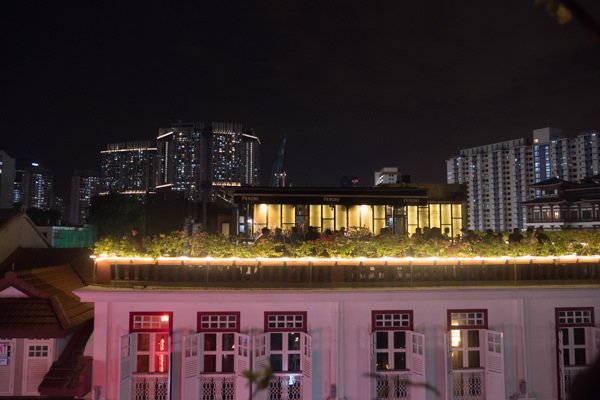
Ann Siang Hill and Club Street near Chinatown are good places to go for dining or drinking, as you’ll find many restored buildings here housing wine bars, cocktails bars, and restaurants. There are a bunch of 3rd and 4th floor rooftop terraces here that will give you a view of the downtown skyline. Try Tiger’s Milk, Oxwell & Co., FRY Rooftop Bistro & Bar, or The Screening Room.
Cost: the price of your drinks
Go on a Night Safari
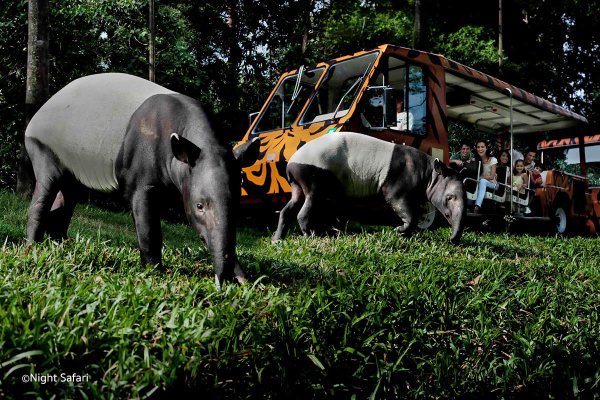
Singapore has a world-renowned zoo, though I must admit I was a bit bummed out by the behavior of some of the animals. I saw two white tigers pacing back and forth constantly for hours, clearly having an awful life. I think there are plenty of better opportunities around Southeast Asia to see wildlife in their natural habitat.
That said, Singapore’s Night Safari is easier to recommend, as all the animals share a huge space and visitors take a little tram through it at night. The experience is fun for children and adults alike — and is arguably much more worthwhile than a regular zoo, as you’ll get to see nocturnal animals that are normally sleeping during the day. It’s a bit difficult to reach by MRT, so you might have to take a taxi.
Cost: $ 47 SGD
Enjoy the amazing airport

It might seem silly to mention the airport as a top place to see in Singapore, but it honestly is amazing! Changi Airport keeps winning awards for its comfort and amenities, and it might well be my personal favorite airport in the world.
There’s a butterfly garden, a cactus garden, a swimming pool with jacuzzi, a free movie theatre, and much more. No, these aren’t hidden away inside some VIP lounge, but freely accessible once you get past security. A new 10-story indoor canopy park is opening in 2019.
Cost: free if you’re flying
Travel costs for Singapore
So how expensive is Singapore really?
I guess the annoying answer is: ‘it depends’.
Singapore is easily the most expensive place in the region, but that doesn’t mean you can’t get by on a budget.
Transportation doesn’t have to cost much, thanks to Singapore’s excellent metro system. You can get from one side of the island to the far opposite side (about 50km) for just 2 Singapore dollars (about $1.50 US), and it’s less for shorter trips. Not bad! The MRT metro connects all the key places as well as to Changi International Airport.
Food can be very inexpensive too. It really depends on where you eat. Restaurants charge just as much as you’d expect in any ‘Western’ countries. But if you go to any of Singapore’s famed hawker centers, you can get a solid meal for just a couple of bucks.
Accommodation is likely to be your biggest expense. A room in a budget hotel costs at least about USD $50 a night, and you can expect a hostel dorm bed to cost around USD $15 to USD $20. That’s not unusual by international standards, but this can be jarring if you just spent, say, USD $8 a night for a private bungalow in rural Laos. Airbnbs and hostels are nice options in Singapore. If you’re not into sharing a room in a hostel, there are quite a few boutique capsule hostels (which give you a private ‘pod’).
Ultimately, Singapore can be as cheap or as expensive as you want.
If you stay in hotels, take taxis, dine in restaurants, and drink sumptuous cocktails in Singapore’s most trendy bars, you could easily burn through $200+ USD a day.
But if you stay in hostels, use the metro system, avoid most of the ticketed tourist sites, and eat at hawker centers, you can still get by on about $40 USD a day.
A couple more tips
Don’t let taxis refuse you
I wrote earlier that Singapore is nearly free of hassle. Well, the only frustration I’ve had is that some taxis may refuse to take you, suddenly deciding it’s time to ‘change shifts’ when your destination is not convenient for them.
This behavior is actually illegal, and if you point this out to them they’ll happily take you where you need to be.
Sentosa Island is not that exciting
Sentosa Island is often mentioned as a great place to go, but honestly I don’t think it’s that interesting. It’s essentially an artificial simulation of a tropical island, filled with theme parks, golf courses, and hotels. The beach looks out onto one the world’s busiest shipping lanes, so the waters are littered with container ships and oil tankers.
Sentosa might be a good place for entertainment for residents and families, but for visitors who want to explore in Singapore, it’s probably not that compelling. If Singapore happens to be just a stopover for you on a Southeast Asia trip, I’d recommend going to a real tropical island (of which there are so many in neighboring countries).
Try the local specialities
Be sure to try one of the national dishes, simply named “chicken rice”. It looks like just some plain rice with plain chicken, but don’t let its humble appearances deceive you. What seems like a dull plate of food is actually the product of an elaborate cooking process in which the meat is gradually and gently steamed… with a very tender and delicious result.
Another famous dish in Singapore is the Chili Crab. Oh, and the eponymous gin-based cocktail Singapore Sling (once originating from the Raffles Hotel bar) is not a bad choice for a drink!





























